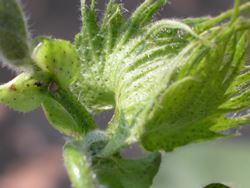Insecticide Strategies For Early Season Plant Bug Management

Note the abscission scar left by a shed square at the second position fruiting site.
DR. SCOTT STEWART
JACKSON, TENN.
We are closing in our early squaring for the earliest planting cotton, so now seems to be a good time to review insecticide management strategies. First I will remind you that treatment thresholds for preflowering plants bug infestations are based primarily on sweep net sampling and square retention. The goal is to maintain 80 percent or higher square retention as the crop enters early bloom.
• Treatment for tarnished plant bug is recommended during the first two weeks of squaring when an average 8 or more plant bugs are found per 100 sweeps.
• After the second week of squaring, the treatment threshold increases to 15 or more plant bugs per 100 sweeps.
The standard method to assess square retention is to examine first position squaring sites on the tops 5 nodes of the plant on at least 25 plants per field. We have excellent data that shows populations below the above thresholds rarely cause more than 20 percent square loss. However, these threshold should be reduced to help increase if square retention drops below 85 percent. Indeed, I would consider halving these thresholds if retention drops below 75 percent. Timeliness of application is very important and obviously more important when infestation levels are well above threshold.
The old automatic ‘pinhead square’ application is not a generally recommended approach. This terminology stems from the days of the boll weevil when an insecticide application or two was suggested beginning at pinhead square to kill overwintering boll weevils as they infested fields. Automatic plant bug applications are not encouraged, and I would only consider this if there was not a scout or crop consultant checking the crop. There a reams of data that indicate 80 percent of higher square retention is sufficient to maintain maximum yield potential. Believe it or not, there is as much or more data suggesting that 95-100 percent retention can ultimately hurt yields more than 80-85 percent retention. The moral is don’t panic if your square retention falls a little below 80 percent.
Insecticide selection is pretty simple prior to flowering. I agree with most folks that use either Centric (1.5 – 2.0 oz/acre) or one of the many imidacloprid products (at the full labeled rate). I lean towards Centric for infestations that are well above threshold. Some people even elect to mix a lower rate of Centric with imidacloprid to improve the ‘knock down’ of imidacloprid for a similar or reduced cost compared with a higher rate of Centric. Transform at 1.5 oz/acre is another option, but I think the biggest bang for the buck is to use this product during early and mid-bloom as immature plant bugs become a bigger part of the equation. That’s when it will really distinguish itself.
Remember that cotton aphids have developed resistance to the neonicotinoid insecticides such as Centric and imidacloprid. They may not provide adequate control. I would suggest using Transform or Carbine (2.6-2.8 oz/acre) for plant bug control if aphids are present in significant numbers. Insecticides recommended for plant bug control can be found in the UT’s Insect Control Recommendations for Cotton. Also remember that the use of pyrethroid insecticides and Acephate/Orthene is discouraged prior to bloom. They are especially prone to flaring aphid and mite populations, and plant bugs are highly resistance to the pyrethroid insecticides anyway.
Although some Midsouthern states recommend the use of Diamond during the third week of squaring, I typically suggest delaying its use until early bloom. This timing has worked better for me in our geography. Diamond also can flare secondary outbreaks of aphids and spider mites, and this is another reason I prefer delaying its use until early flowering. Remember that Diamond does not kill adult plant bugs, so a tank-mix partner if often needed. The use of Diamond, Transform and other insecticide options will be addressed further as we near bloom. ∆
DR. SCOTT STEWART: IPM Extension Specialist, University of Tennessee